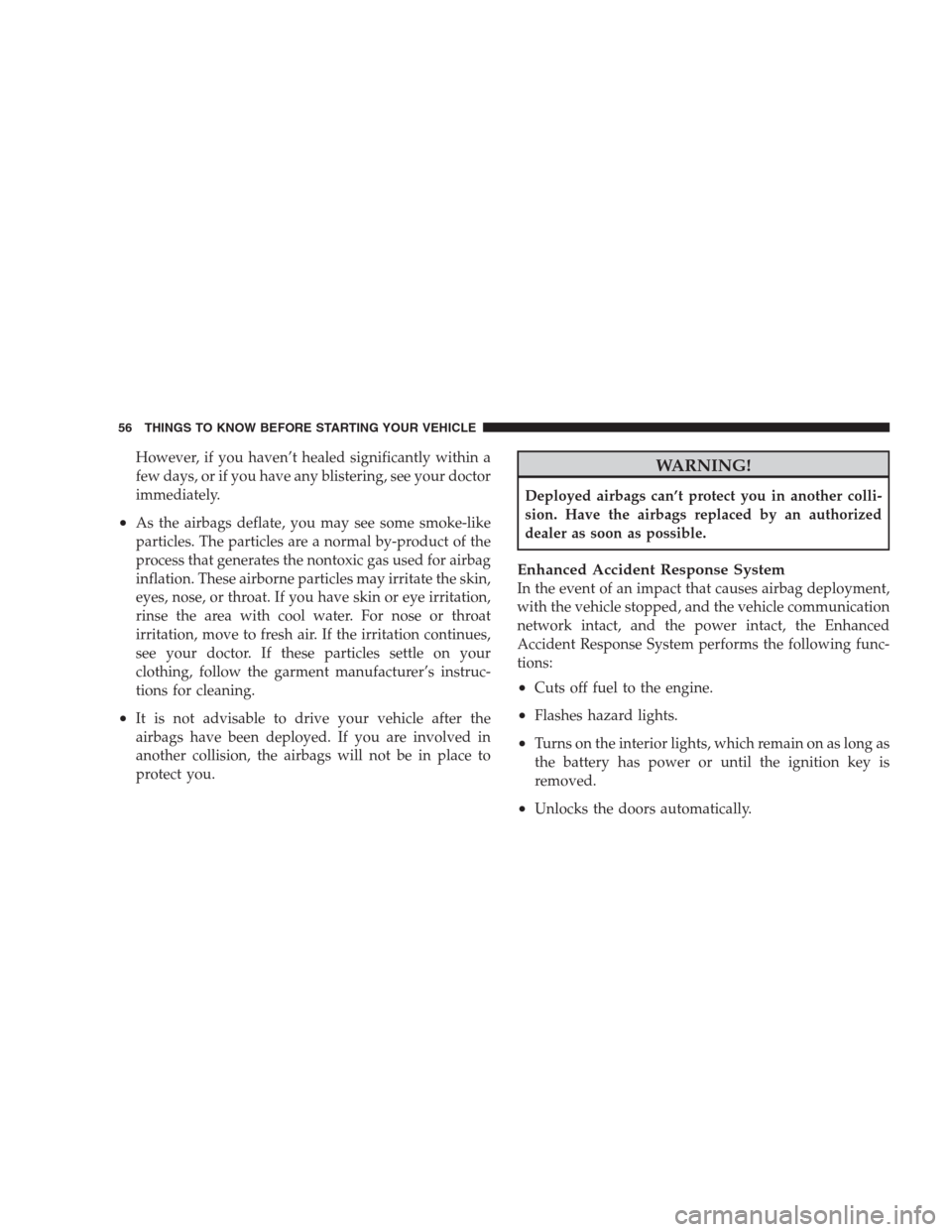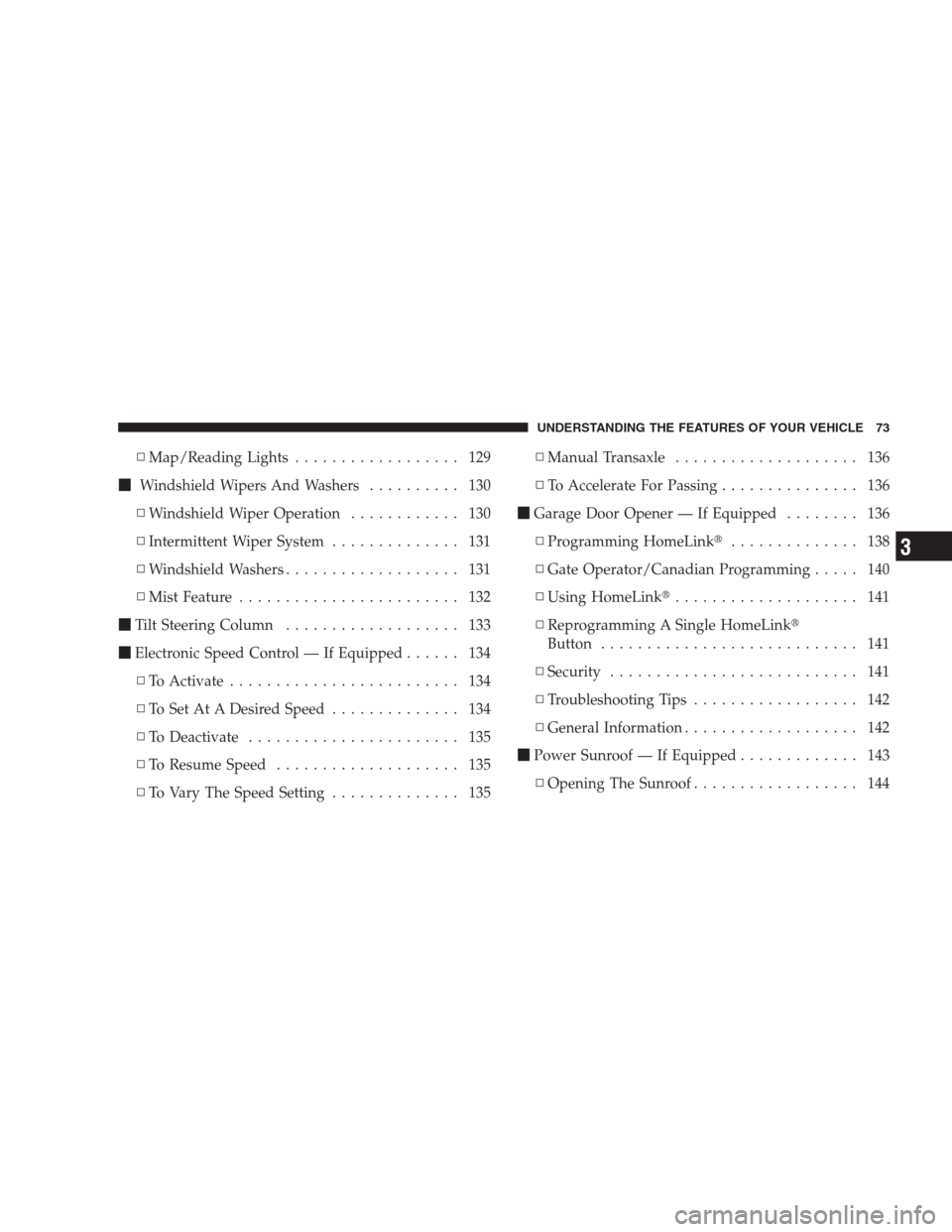Page 58 of 457

However, if you haven’t healed significantly within a
few days, or if you have any blistering, see your doctor
immediately.
•As the airbags deflate, you may see some smoke-like
particles. The particles are a normal by-product of the
process that generates the nontoxic gas used for airbag
inflation. These airborne particles may irritate the skin,
eyes, nose, or throat. If you have skin or eye irritation,
rinse the area with cool water. For nose or throat
irritation, move to fresh air. If the irritation continues,
see your doctor. If these particles settle on your
clothing, follow the garment manufacturer’s instruc-
tions for cleaning.
•It is not advisable to drive your vehicle after the
airbags have been deployed. If you are involved in
another collision, the airbags will not be in place to
protect you.
WARNING!
Deployed airbags can’t protect you in another colli-
sion. Have the airbags replaced by an authorized
dealer as soon as possible.
Enhanced Accident Response System
In the event of an impact that causes airbag deployment,
with the vehicle stopped, and the vehicle communication
network intact, and the power intact, the Enhanced
Accident Response System performs the following func-
tions:
•Cuts off fuel to the engine.
•Flashes hazard lights.
•Turns on the interior lights, which remain on as long as
the battery has power or until the ignition key is
removed.
•Unlocks the doors automatically.
56 THINGS TO KNOW BEFORE STARTING YOUR VEHICLE
Page 59 of 457

Maintaining Your Airbag System
WARNING!
•Modifications to any part of the airbag system
could cause it to fail when you need it. You could
be injured because the airbags are not there to
protect you. Do not modify the components or
wiring, including adding any kind of badges or
stickers to the steering wheel hub trim cover or the
upper passenger side of the instrument panel. Do
not modify the front bumper, vehicle body struc-
ture, or frame.
•You need proper knee impact protection in a
collision. Do not mount or locate any aftermarket
equipment on or behind the knee impact bolster.
•It is dangerous to try to repair any part of the
airbag system yourself. Be sure to tell anyone who
works on your vehicle that it has airbags.
Airbag Warning Light
You will want to have the airbags ready to
inflate for your protection in an impact. While
the airbag system is designed to be mainte-
nance free, if any of the following occurs, have
an authorized dealer service the system promptly:
•The Airbag Warning Light does not come on or flickers
during the six to eight seconds when the ignition
switch is first turned on.
•The light remains on or flickers after the six to eight
second interval.
•The light flickers or comes on and remains on while
driving.
THINGS TO KNOW BEFORE STARTING YOUR VEHICLE 57
2
Page 61 of 457

upon request. General data that does not identify par-
ticular vehicles or crashes may be released for incorpo-
ration in aggregate crash databases, such as those main-
tained by the U.S. government and various states. Data of
a potentially sensitive nature, such as would identify a
particular driver, vehicle, or crash, will be treated confi-
dentially. Confidential data will not be disclosed by
Chrysler LLC to any third party except when:
1. Used for research purposes, such as to match data
with a particular crash record in an aggregate database,
provided confidentiality of personal data is thereafter
preserved
2. Used in defense of litigation involving a Chrysler LLC
product
3. Requested by police under a legal warrant
4. Otherwise required by lawData parameters that may be recorded:
•Diagnostic trouble code(s) and warning light status for
electronically-controlled safety systems, including the
airbag system
•Airbag disable light status (if equipped)
•�Time�of airbag deployment (in terms of ignition
cycles and vehicle mileage)
•Airbag deployment level (if applicable)
•Impact acceleration and angle
•Seat belt status
•Brake status (service and parking brakes)
•Accelerator status (including vehicle speed)
•Engine control status (including engine speed)
•Transmission gear selection
THINGS TO KNOW BEFORE STARTING YOUR VEHICLE 59
2
Page 72 of 457

Airbag Warning Light
The light should come on and remain on for six to eight
seconds as a bulb check when the ignition switch is first
turned ON. If the LED is not lit during starting, have it
checked. If the light stays on, flickers, or comes on while
driving, have the system checked by an authorized
dealer.
Defroster
Check operation by selecting the defrost mode and place
the blower control on high speed. You should be able to
feel the air directed against the windshield. See your
authorized dealer for service if your defroster is
inoperable.
Periodic Safety Checks You Should Make Outside
The Vehicle
Tires
Examine tires for excessive tread wear or uneven wear
patterns. Check for stones, nails, glass, or other objects
lodged in the tread. Inspect tread and sidewall for cuts or
cracks. Check the wheel nuts for tightness. Check the
tires (including spare) for proper pressure.
Lights
Have someone observe the operation of exterior lights
while you work the controls. Check turn signal and high
beam indicator lights on the instrument panel.
Fluid Leaks
Check the area under the vehicle after overnight parking
for fuel, engine coolant, oil or other fluid leaks. Also, if
gasoline fumes are detected or fuel, power steering fluid,
transmission fluid or brake fluid leaks are suspected, the
cause should be located and corrected immediately.
70 THINGS TO KNOW BEFORE STARTING YOUR VEHICLE
Page 74 of 457

�Voice Recognition System (VR) —
If Equipped........................... 109
▫Voice Recognition System (VR) Operation . . . 109
▫Commands..........................111
▫Voice Training....................... 114
�Seats............................... 114
▫Front Seat Adjustment................. 114
▫Manual Seat Height Adjustment —
If Equipped......................... 115
▫Manual Lumbar — If Equipped.......... 116
▫Driver’s Seatback Recline............... 116
▫Adjustable Head Restraints.............. 117
▫Heated Seats — If Equipped............. 117
▫Fold-Flat Front Passenger Seat........... 119▫Folding Rear Seat.................... 120
�To Open And Close The Hood............. 121
�Lights.............................. 123
▫Multifunction Lever................... 123
▫Headlights, Parking Lights And Instrument
Panel Lights........................ 123
▫Lights-On Reminder.................. 124
▫Fog Lights — If Equipped.............. 124
▫Daytime Running Lights (DRL) —
If Equipped......................... 125
▫Turn Signals........................ 126
▫High Beam/Low Beam Select Switch....... 126
▫Flash-To-Pass....................... 127
▫Off-Road Lights — If Equipped.......... 127
72 UNDERSTANDING THE FEATURES OF YOUR VEHICLE
Page 75 of 457

▫Map/Reading Lights.................. 129
�Windshield Wipers And Washers.......... 130
▫Windshield Wiper Operation............ 130
▫Intermittent Wiper System.............. 131
▫Windshield Washers................... 131
▫Mist Feature........................ 132
�Tilt Steering Column................... 133
�Electronic Speed Control — If Equipped...... 134
▫To Activate......................... 134
▫To Set At A Desired Speed.............. 134
▫To Deactivate....................... 135
▫To Resume Speed.................... 135
▫To Vary The Speed Setting.............. 135▫Manual Transaxle.................... 136
▫To Accelerate For Passing............... 136
�Garage Door Opener — If Equipped........ 136
▫Programming HomeLink�.............. 138
▫Gate Operator/Canadian Programming..... 140
▫Using HomeLink�.................... 141
▫Reprogramming A Single HomeLink�
Button............................ 141
▫Security........................... 141
▫Troubleshooting Tips.................. 142
▫General Information................... 142
�Power Sunroof — If Equipped............. 143
▫Opening The Sunroof.................. 144
UNDERSTANDING THE FEATURES OF YOUR VEHICLE 73
3
Page 76 of 457

▫Closing The Sunroof.................. 144
▫Pinch Protect Feature.................. 144
▫Pinch Protect Override................. 145
▫Venting Sunroof — Express............. 145
▫Sunshade Operation................... 145
▫Wind Buffeting...................... 145
▫Sunroof Maintenance.................. 146
▫Ignition Off Operation................. 146
�Electrical Power Outlets................. 146
�Power Inverter — If Equipped............ 148
�Cupholders.......................... 150
�Storage............................. 151
▫Glove Compartment And Storage Bin...... 151▫Door Storage — If Equipped............. 152
�Console Features...................... 153
�Cargo Area Features.................... 154
▫Cargo Light/Removable Self-Recharging
Flashlight — If Equipped............... 154
▫Cargo Cover — If Equipped............. 155
▫Removable Load Floor................. 156
▫Cargo Tie-Down Loops................ 156
▫Fold Down Speakers — If Equipped....... 157
�Rear Window Features.................. 157
▫Rear Window Wiper/Washer............ 157
▫Rear Window Defroster................ 158
�Roof Luggage Rack — If Equipped......... 159
74 UNDERSTANDING THE FEATURES OF YOUR VEHICLE
Page 77 of 457
MIRRORS
Inside Day/Night Mirror
A two-point pivot system allows for horizontal and
vertical mirror adjustment. Adjust the mirror to center on
the view through the rear window.
Headlight glare can be reduced by moving the small
control under the mirror to the night position (toward the
rear of vehicle). The mirror should be adjusted while set
in the day position (toward the windshield).
Adjusting Rearview Mirror
UNDERSTANDING THE FEATURES OF YOUR VEHICLE 75
3